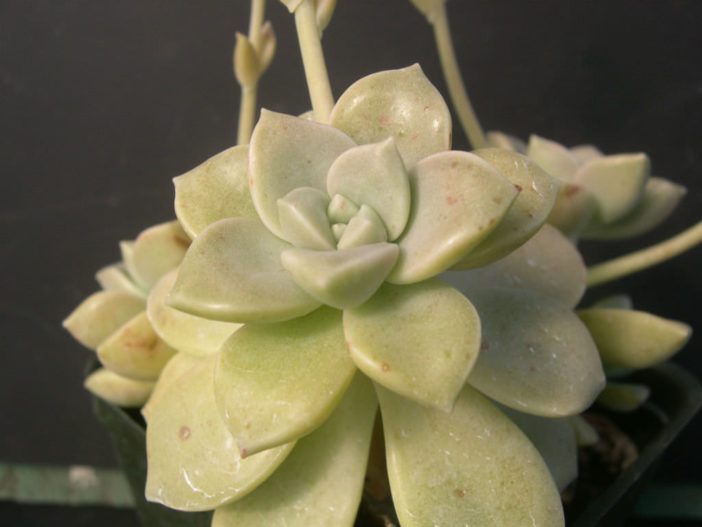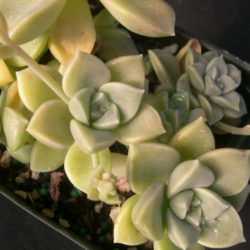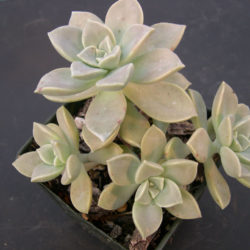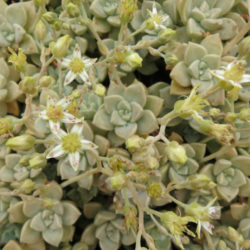Scientific Name
Graptopetalum paraguayense subsp. bernalense M. Kimnach & R. Moran
Common Name(s)
Ghost Plant
Synonym(s)
Byrnesia bernalensis, Graptopetalum bernalense
Scientific Classification
Family: Crassulaceae
Subfamily: Sedoideae
Tribe: Sedeae
Subtribe: Sedinae
Genus: Graptopetalum
Origin
This subspecies is native to Mexico. However, it is only known from the type locality in Tamaulipas, where it grows on north-exposed porphyric rocks from 2,300 to 2,620 feet (700 to 800 m) above sea level.
Description
Graptopetalum paraguayense subsp. bernalense, also known as Graptopetalum bernalense, is a very interesting succulent shrublet that forms relatively small rosettes at the end of decumbent or pendent stems. It differs from Graptopetalum paraguayense subsp. paraguayense by being smaller in all its parts. The rosettes are up to 2.4 inches (6 cm) in diameter. Leaves are yellowish or greenish-cream and become pinkish under stress. They are obovate, up to 1.4 inches (3.5 cm) long, and up to 0.6 inches (1.5 cm) wide.
Flowers are star-shaped, 5-merous, up to 0.6 inches (1.5 cm) in diameter, and appear in branched inflorescences in spring. They are pure white or with a few red blotches.

Hardiness
USDA hardiness zones 9a to 11b: from 20 °F (−6.7 °C) to 50 °F (+10 °C).
How to Grow and Care
The rules for Graptopetalum care are similar to those for most succulents. All require lots of sunlight to look their best. They need gritty porous soil with excellent drainage. Water regularly over the summer months letting the soil dry out between waterings. Minimal water is required over winter. Overwatering is a cause of root rots, and the plant can get several pest infestations. Fertilize once during the growing season with a balanced fertilizer diluted to ¼ strength.
The Graptopetalums are generally easily propagated by seeds, leaf cuttings, or offsets. Any rosette that breaks off has the potential to root and start a new plant. Even a leaf that drops off will quickly root below the parent plant and produce a new rosette. The new plant feeds off the leaf until it shrivels and falls off. The new little ghost plant has rooted and sprouted new leaves by then.
See more at How to Grow and Care for Graptopetalum.
Links
- Back to genus Graptopetalum
- Succupedia: Browse succulents by Scientific Name, Common Name, Genus, Family, USDA Hardiness Zone, Origin, or cacti by Genus
Photo Gallery
Click on a photo to see a larger version.



